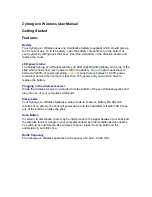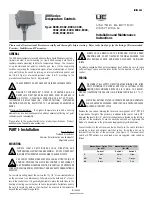
AWAG Elektrotechnik AG Sandbüelstrasse 2 CH-8604 Volketswil
3410000.docx / 1876110
Tel. +41 44 908 19 19 Fax +41 44 908 19 99 [email protected] www.awag.ch
SW: UPH_V181219 / 31.12.2018 Seite 3 / 8
ANW E NDUNGE N
In der Grundfunktion zur Temperaturregelung in Einzelräumen wird der Omnio
Thermostataktor UPH230/10 zusammen mit einem Omnio Raumfühler RTF161
und einem 230 V~ Stellventil verwendet. Daneben stellt der Aktor aber noch weitere
nützliche Funktionen zur Verfügung. Zu beachten ist jedoch, dass die Grundfunk-
tion stets eingelernt werden muss.
AP P LI C ATI O NS
In the basic function for temperature control in individual rooms, the Omnio thermo-
stat actuator REGH12/08 is used together with an Omnio room sensor RTF161 and
a 230 V~ control valve. In addition, the actuator provides other useful functions.
Please note, however, that the basic function must always be taught-in.
G R U N D F U N K T I O N
Für die Einzelraumregelung braucht es einen
Raumfühler, den Thermostataktor UPH230/10 und
ein Stellventil. Der Raumfühler sendet Temperatur
und Sollwert per Funk an den Thermostataktor. Die
gewünschte Raumtemperatur wird am Raumfühler
über die Bedientasten eingestellt (Sollwert). Der
Raumfühler wird als Funktion
H01: Raumfühler
eingelernt.
F E N S T E R Ü B E R W AC H U N G
Zusätzlich zur Einzelraumregelung kann mit einem
Omnio Fensterkontakt ein Fenster oder eine Tür
überwacht werden. Solange das Fenster oder die
Tür offen ist, bleibt die Heizung ausgeschaltet.
Sinkt dabei die Temperatur unter 8 °C, schaltet die
Heizung automatisch auf Notbetrieb (Frostschutz)
um. Der Fensterkontakt wird als Funktion
H04:
Fensterkontakt
eingelernt.
Fenster und Türen können auch mit Omnio Fens-
ter- und Türgriffen überwacht werden. Tür- und
Fenstergriffe haben neben geschlossen und offen
noch die Stellung gekippt. Es kann festgelegt wer-
den, ob die Stellung gekippt als Fenster offen oder
Fenster geschlossen zählt. Der Fenstergriff wird
als Funktion
H05: Fenstergriff
eingelernt.
N AC H T A B S E N K U N G
Mit einem Omnio Wandsender lässt sich die Tem-
peratur während der Nacht bequem per Tasten-
druck absenken. Der Wandsender wird als Funk-
tion
H03: Sollwertschiebung
eingelernt, wobei
Temperatur und Dauer der Absenkung frei gewählt
werden können.
Z W E I T E R S O L L W E R T
Ein weiterer Raumfühler kann als zweiter Sollwert
verwendet werden, z.B. um die Temperatur bei Ab-
wesenheit mit einem tieferen Sollwert zentral zu re-
geln. Der zusätzliche Raumfühler gibt jedoch nur
den zweiten Sollwert vor, die Temperatur wird wei-
terhin vom lokalen Raumfühler übernommen. Mit
einem Wandsender schaltet man vom einen zum
anderen Sollwert um. Der Wandsender wird als
Funktion
H07: Sollwertumschaltung mit Wippe
ein-
gelernt, der zweite Raumfühler als Funktion
H06:
Zweiter Sollwert
.
Bei Hotelzimmern erfolgt die Umschaltung in der
Regel über einen Key-Card Schalter, welcher als
Funktion
H08: Sollwertumschaltung mit Key-Card
Schalter
eingelernt wird.
F E S T E R S O L L W E R T
Soll die lokale Einstellung des Sollwerts durch den
Benutzer verhindert werden, kann man eine feste
Sollwertvorgabe einrichten. Der Sollwert wird im
Thermostataktor gespeichert und kann nur über E-
Tool verändert werden. Als Sensor reicht in diesem
Fall auch ein Temperaturfühler ohne Sollwert, wel-
cher anstelle der Grundfunktion H01 als Funktion
H09: Temperatur von Raumfühler
eingelernt wird.
E X T E R N E R S O L L W E R T
Der Sollwert kann auch durch ein übergeordnetes
System wie beispielsweise eine Visualisierung vor-
gegeben werden mittels EEP D2-34-00 (cmd 5).
Das EnOcean Gateway der Visualisierung wird als
X01: Gateway
eingelernt. Als Sensor reicht in die-
sem Fall auch ein Temperaturfühler ohne Sollwert,
welcher anstelle der Grundfunktion H01 als Funk-
tion
H09: Temperatur von Raumfühler
eingelernt
wird.
B AS I C F U N C T I O N
Individual room control requires a room sensor, a
thermostat actuator and a control valve. The room
sensor transmits the temperature and setpoint to
the thermostat actuator via radio. The desired room
temperature is set at the room sensor using the
control buttons (set point). The room sensor is
taught-in as function
H01: room sensor.
W I N D O W M O N I T O R I N G
In addition to individual room control, a window or
door can be monitored with a window contact. As
long as the window or door is open, the heating re-
mains switched off. If the temperature falls below 8
°C, the heating automatically switches to emer-
gency operation (frost protection). The window
contact is taught-in as function
H04: window con-
tact.
Windows and doors can also be monitored with
Omnio window and door handles. Besides the
open and closed position, the door and window
handles register the tilted position. It can be deter-
mined whether the tilted position counts as an open
window or a closed window. The window handle is
taught-in as function
H05: window handle.
N I G H T S E T B A C K
With an Omnio wall transmitter, the temperature
can be conveniently lowered during the night at the
touch of a button. The wall-mounted transmitter is
taught-in as function
H03: setpoint shift
, whereby
the temperature and duration of the reduction can
be freely selected.
S E C O N D S E T P O I N T
An additional room sensor can be used as a sec-
ond setpoint, for instance to centrally control the
temperature during absence with a lower setpoint.
However, the additional room sensor only specifies
the second setpoint; the temperature is still taken
over by the local room sensor. A wall transmitter is
used to switch from one setpoint to the other. The
wall transmitter is taught-in as function
H07: Set-
point changeover with rocker
, the second room
sensor as function
H06: Second setpoint.
In hotel rooms, the changeover is usually made via
a key card switch, which is taught-in as function
H08: Setpoint changeover with key card switch
.
F I X E D S E T P O I N T
If the local setting of the setpoint is to be blocked
for the user, a fixed setpoint can be set. The set-
point is stored in the thermostat actuator and can
only be changed using the E-Tool. In this case, a
temperature sensor without a setpoint value is also
sufficient as a sensor, which is taught-in as function
H09: Temperature from room sensor
instead of the
basic function H01.
E X T E R N A L S E T P O I N T
The setpoint value can also be specified by a
higher-level system such as a visualization using
EEP D2-34-02 (cmd 5). The EnOcean gateway of
the visualization is taught-in as
X01: Gateway
. In
this case, a temperature sensor without a setpoint
is also sufficient as a sensor, which is taught-in as
function
H09: Temperature of room sensor
instead
of the basic function H01.


























